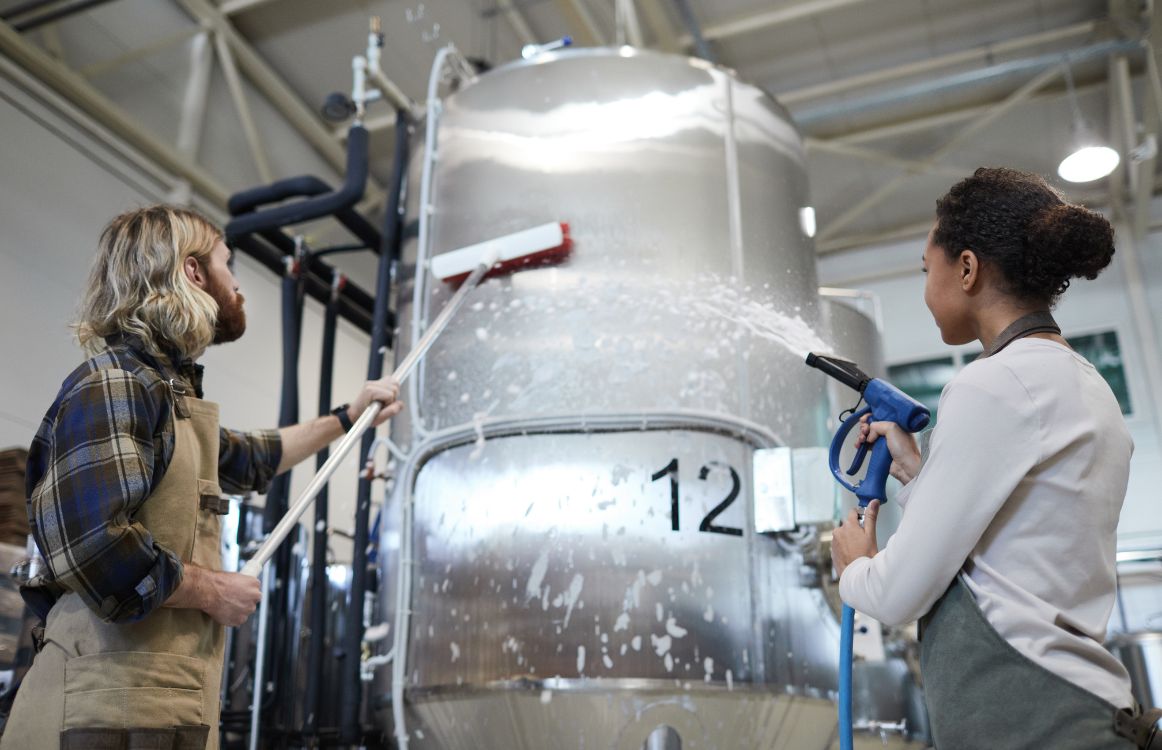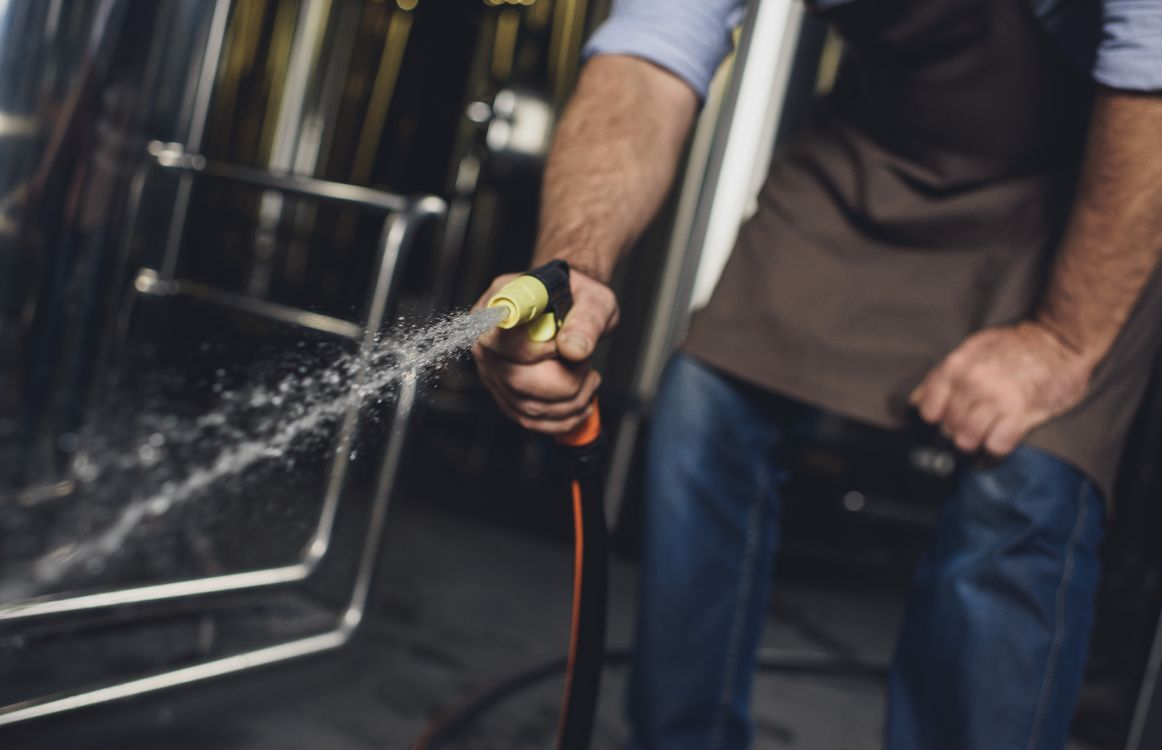CIP Chemicals for Breweries
For brewers, one of the biggest concerns has to be about cleaning. But which CIP chemicals for breweries are best, and what even is CIP? To these questions, and so many more, it’s great to have answers before jumping into brewing, so you don’t end up having to toss a perfectly good batch of brew due to a sneaky pathogen.
What Is CIP in the Brewery Industry?

To begin, what is CIP in the brewing industry? CIP refers to clean-in-place processes and systems that allow brewers to clean their large brewing equipment without having to dismantle it. It can be extremely labor intensive to take apart a mash tun or kettle piece by piece to clean it. Not to mention the risk of then introducing new potential contaminants when putting it all back together.
It is so much easier to simply implement cleaning strategies and use the best chemicals to clean your equipment as it stands.
The problem is you don’t want to use just any chemicals and cleaners. Cleaners that are not strong enough may leave room for some nasty invaders behind and those that are too strong or caustic may corrode your equipment or end up in your brew, making a bad situation worse.
It is important to remember that what we are looking for in brewing is not an entirely sterile environment. We are not worried about getting our clients sick. Fortunately, the alcohol and the hops in the beer will take care of that – being both antibiotic, probiotic, and their own form of sanitizer.
Alcohol will kill of 99.9% of pathogens that could harm humans, and hops go a long way toward preserving your beer.
It is (other) bacteria and other pathogens or chemicals that cause off flavors we are hoping to kill off and prevent from getting into the brew.
You don’t want to go to all the trouble of mastering a craft brew only to have microbes invade the batch and produce baby vomit flavors, or old band aids hints and notes.
The aroma and flavor of your beer are everything, and we need to implement exacting CIP systems with the proper chemicals to ensure we only get the aromas and flavors we want.
Typical CIP Issues
Because we are dealing with food grade issues, we have to take into consideration the outcomes of working with food products on our equipment.
If you don’t use the proper chemicals, you may find that the cleaning products you use interact with the proteins, carbohydrates, and minerals left behind from your brew, making an even bigger mess than you had originally.
This interaction can show up as strong brown colors left as residue after cleaning, excessive foaming during cleaning, caramelization of remaining sugars, crystallization of cleaning chemicals, hardening of water, and more.
Equipment
The most common issues to arise when dealing with CIP systems and cleaners are with the mash tun and the kettle.
With the mash tun, the proteins from the malt can get stuck in the bottoms of the screens, and the hoses will only spray the tops. Thus, you will have to remove the screens and scrub and rinse the bottoms of the screens by hand to remove all the soil.
For the kettle, the steaming element often bakes soil into the surface and calcium gets deposited on heated areas. Thus, the brewer must climb into the kettle and scrub all surfaces that still have soil after the initial cleaning.
Finally, the heat exchanger can be a problem to clean because there are so many components. This piece of equipment is one that must be taken apart entirely to clean as it can be a primary point of concern when it comes to contaminants.
What Chemicals Are Used for CIP?

Thus, it is critical to use a caustic blend of cleansers that includes chelating and sequestering agents like EDTA (ehtylenediaminetetraacetic), IDS (iminodisuccinate), and MGDA (methylglycinediacetic acid), which all have a reputation for tolerating issues like water hardness and calcium deposits.
You can also invest in chemicals that inhibit thresholds like phosphonates and polyacrylates, which will also work to prevent water hardness and allow for a clean rinse.
Non-ionic surfactants are also helpful to brewers in the cleaning process as they prevent excessive foaming as well as the increase of viscosity, which ensures you leave a clean surface that has no residue left behind. These surfactants will additionally lend themselves to better wetting and penetration of the matter to be cleaned, which will allow for an easier and quicker rinse.
Thus, the primary cleaners many brewers adopt for CIP systems include a caustic soda like sodium hydroxide and chlorinated alkaline cleaners because they meet all of the above needs.
You can also employ an alternative caustic soda in the form of potassium hydroxide. Either caustic soda should be used at a concentration between 1% and 4%.
But beware that these caustic chemicals are dangerous, can set beerstone, a brown stain that forms on the equipment, and it must be neutralized before it can be disposed of.
Some brewers have taken to adding 1 oz of 34% hydrogen peroxide to their caustic cleaning solution to enhance the power of the cleaner. Be mindful that this combination can cause a violent chemical reaction, though. So only add the hydrogen peroxide once all other chemicals have been combined and mixed well, right before you plan to clean.
You can always choose to work instead with a non-caustic cleaner like sodium carbonate or sodium metasilicate, which can be used in concentrations of 2 oz. per gallon of water and at a temperature higher than 70 degrees Fahrenheit.
While these non-caustic cleaners will get you a great clean when used correctly and for at least 30 minutes, avoiding all the problems that may arise with caustic cleaners, they cannot be reused, and they are expensive.
Still, it seems worth the investment. Just be sure to rinse well.
Cheers!
Are you still pitching fresh yeast every time? By reusing your yeast, you can save up to hundreds of thousands of dollars per year on just yeast alone!
Join the hundreds of brewers from all around the world using the Smartest Automated Yeast Cell Counter! Request a Free Demo Account today and experience firsthand how Oculyze can take your brewery to the next level!
Sources:
- https://www.alfalaval.com.au/media/stories/beverage-processing/tank-cleaning-and-cip-for-brewers/
- https://www.craftbrewingbusiness.com/featured/cip-cleaning-tips-for-brewhouse-equipment-tackle-everything-from-protein-to-calcium-in-mashtuns-to-kettles/
- https://brewingscience.com/cleaning-and-sanitizing-in-the-brewery/
- https://diversey.com/en/blog/how-can-i-use-less-caustic-my-cip-cleaning-regime
Stay on top on important fermentation insights – subscribe to our monthly newsletter and receive a hand-picked selection of our most relevant articles straight to your inbox.
Never miss a beat and get real time updates with a new article each workday by subscribing our social media channels.
Instagram | Facebook | Twitter | YouTube


